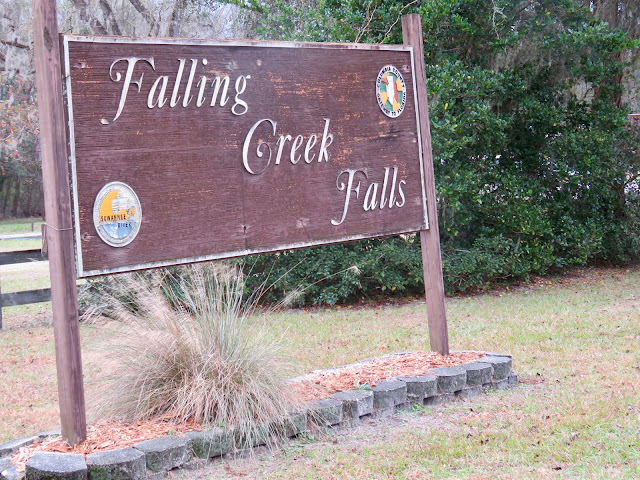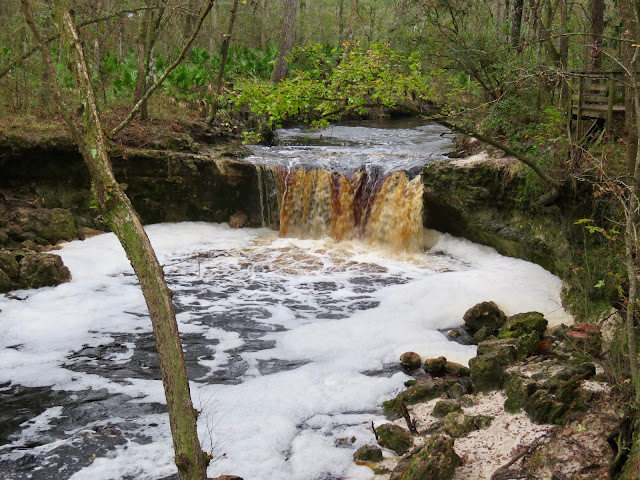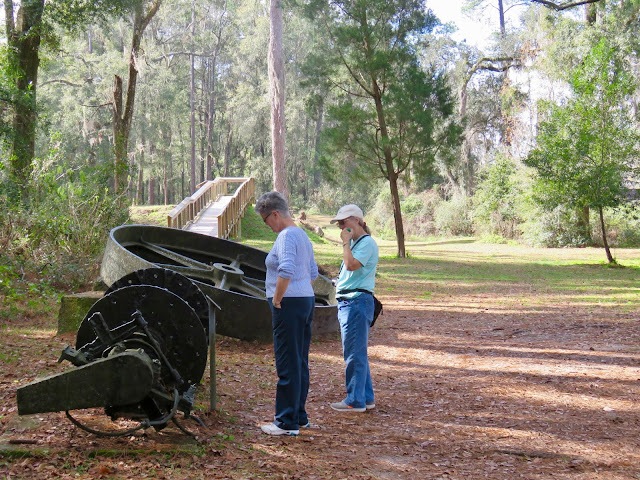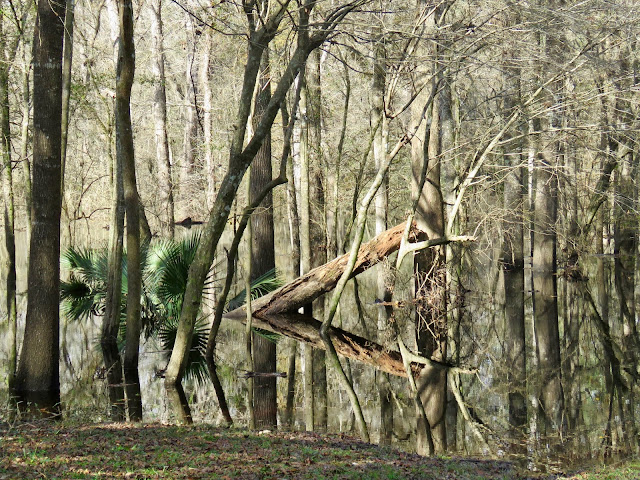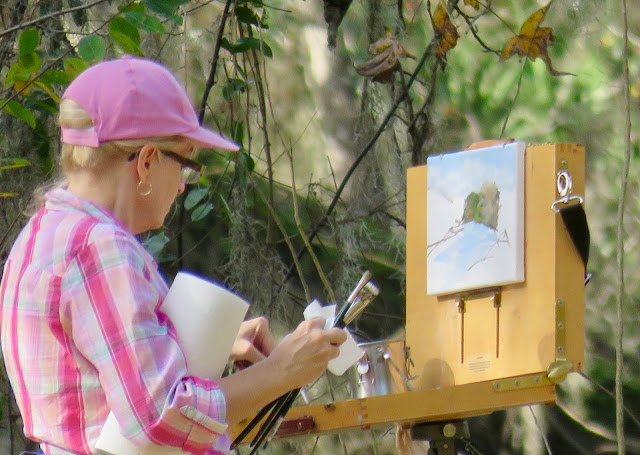January 1, 2019
My life has undergone many happy changes in 2018, and I did not keep up with it in my blog. I'll go back and finish that blog with a summary later. But now that a new year of adventures is about to begin, I decided to go ahead and start a new blog.
Doing a First Day Hike is becoming a tradition since I took up the 52-Hike challenge in 2016. The challenge is to do an average of one hike per week all year, adding up to at least 52 hikes.
This year I challenged my friends to record their hikes too. Linda, Shirley, and Judy joined me on today's hike.
It was 2016 when I first learned that on New Year’s Day, America’s State Parks have all 50 states offering free, guided First Day Hike Programs.
Today's hike was at nearby Suwannee River State Park. Our hike was along the Sandhill Trail, led by Ranger Rianna Elliott, who walked us back in time to the early 1800s when the town of Columbus, located here on the banks of the Suwannee River was one of the largest communities in the state of Florida.
The area surrounding the confluence of the Suwannee and the Withlacoochee was covered in thick forests of yellow pine, just waiting to be harvested. The two major rivers offered an effective transportation route for lumber. Newly-constructed railroads enabled lumber to be shipped across the country at a reasonable fee, and sawmills sprang up around the state.
The confluence of the Withlacoochee River (left) and the Suwannee River (right):
The original railroad bridge built in the 1800s is still in use across the Suwannee River.
It was originally a covered bridge as seen in the photo below. The railroad bridge was part of an important supply line for confederate forces during the Civil War.

Nearby earthworks were built by Confederate soldiers to protect the bridge from Union attack.
In this photo Linda and Judy are looking over a piece of a Steamboat that once carried passengers up and down the Suwannee River to Columbus.
A section of the old railroad line associated with the sawmill.
This is all that remains of a sawmill once located in the area. In the background you can see the Confederate Earthworks.
Crossing the old earthen fort that protected the railroad line.
Remains of a ferry landing that served Columbus can be seen here. There was once a Stage stop here, and parts of the old Stage Road are still passable in the State Park.
A river level measuring station has been built here, and you can see that the river level remains high for this location.
These few things and a small cemetery are all that remain to prove that Columbus ever existed because as the timber industry flourished a new sawmill and town was established across the river. In the 1865’s, lumber magnate George F. Drew (who later became the twelfth governor of Florida, serving from 1877 to 1881) moved to Madison County, Florida, and established what was at the time the largest sawmill in the state of Florida. He named the community which sprang up around the mill Ellaville. In time, the entire community of Columbus moved across the river to Ellaville. Nothing remains of the wooden homes and businesses that existed here. Ellaville too, is now a ghost town.
This is a photo of the sawmill at Ellaville:
Meanwhile, back to our hike along the Sandhill Trail which will take us by the Columbus Cemetery.
On the way we cross the Old Stagecoach Road that led to the ferry landing on the Suwannee River at Columbus.
We were taught the difference between the longleaf pines and the faster growing loblolly pines that grow here.
Longleaf pines take about 100 years to reach maturity. Their cones depend on fire to open and release their seeds. Loblolly pines do not tolerate fires and will be consumed.
The state park conducts controlled burns in the longleaf pine forest to clear out the underbrush and prevent unwanted trees from taking over the forest.
Approaching the Columbus Cemetery...
Family plots are surrounded by cement walls.

Our guide told us some interesting stories about the Cannon family buried here.

Jackson Cannon and his first wife, Phoebe had 5 children and one on the way when he was called away to serve in the Confederate Army during the Civil War. He was captured and sent to a prison camp until the end of the war. Phoebe thought he was dead and in desperate need agreed to marry another man. She had another child by the new husband and was pregnant again when Jackson came home. Jackson was understandably upset about the turn of events and married his second wife, Mollie. He had more children with Mollie who are buried here. But he had compassion on Phoebe and continued to look after her until her death. Phoebe is buried in a nearby churchyard.

Our group listening to the old stories.

Sarah Spencer, buried here died in 1867, 7 weeks after giving birth to a son. Another baby who died in 1865 at age 8 months is buried beside her.

A few graves stand alone, not part of a family plot. There are probably more that have not been found. The foot stone of this grave was uncovered by Hurricane Irma.

Thomas Swift buried in this single gravesite was the blacksmith for the lumber magnate, George Drew.
Beyond the cemetery we came to what the guide called a longleaf pine "nursery."
This first clump of needles protects the seedling from ground fires. It may stay at this phase for a few years before starting to grow taller.

A few trees are destroyed when receiving a direct strike by lightning.
However this tree survived a lightning strike.
We learned that only the outside layers of the tree are "alive" and carry the nutrients to the growing parts of the tree. As long as this side of the tree remains viable, the tree will continue to grow.
I never would have guessed that this plant is a variety of lupine, and produces blue/purple blooms in late spring.
This plant, called Adam's Spike, is in the Yucca family. It grows a tall spike which blooms in summer.
After the tour we returned to the picnic area beside the river to have a picnic lunch.
Then we decided to explore other areas of the park near the river where the trails are flooded. We started at the boat ramp.
The only wildlife we saw were the turtles sunning themselves in the warm sunshine.
Following a service road above a flooded trail.
Linda and Shirley looking over the flooded trail.
We took pictures at the trail's bridge crossing.
But we were not able to cross the bridge which was underwater.
Back at the picnic area, this woman was painting the river.
It was a good way to start the new year.
